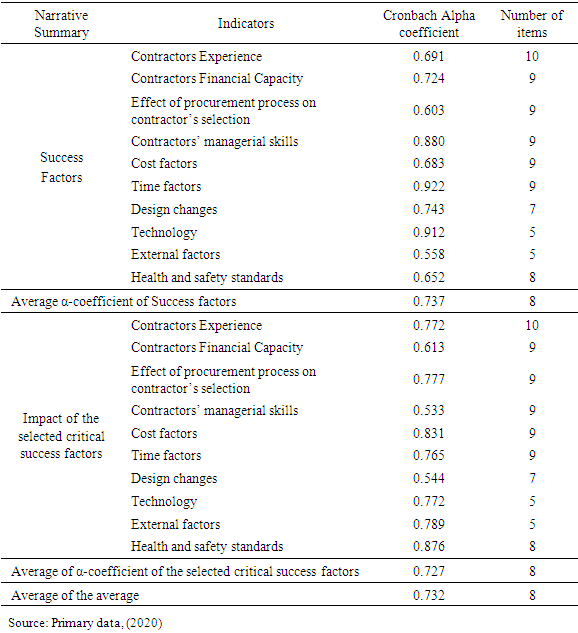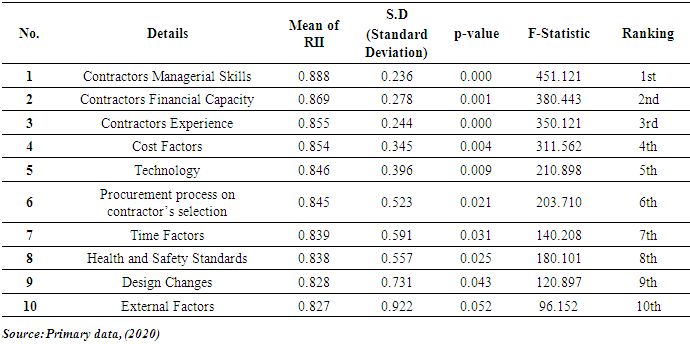-
Paper Information
- Paper Submission
-
Journal Information
- About This Journal
- Editorial Board
- Current Issue
- Archive
- Author Guidelines
- Contact Us
International Journal of Construction Engineering and Management
p-ISSN: 2326-1080 e-ISSN: 2326-1102
2022; 11(2): 53-64
doi:10.5923/j.ijcem.20221102.03
Received: Aug. 18, 2022; Accepted: Sep. 16, 2022; Published: Sep. 23, 2022

Assessment of Performance of Road Maintenance Local Contractors in Uganda: A Case of Uganda National Road Authority Lira Station
Namara Babra Beamanya, Muhwezi Lawrence, Mubiru Joel
Department of Civil and Environmental Engineering, Kyambogo University, Kampala, Uganda
Correspondence to: Namara Babra Beamanya, Department of Civil and Environmental Engineering, Kyambogo University, Kampala, Uganda.
| Email: |  |
Copyright © 2022 The Author(s). Published by Scientific & Academic Publishing.
This work is licensed under the Creative Commons Attribution International License (CC BY).
http://creativecommons.org/licenses/by/4.0/

Proper road maintenance contributes to reliable transport at reduced cost as there is a direct link between road condition and vehicle operating costs. However, there is still inadequate improvement in road maintenance works in Uganda despite of the reforms and increased funding allocated to Works and Transport Sector of Uganda. This study sought to determine the critical factors affecting the performance of local contractors. The leading aim of this study was to develop a framework for improvement of the performance of local contractors in road maintenance projects. Both qualitative and quantitative research methods were employed. Eighty-seven questionnaires were randomly distributed to contractors and 81 questionnaires were received (93.1% respondent rate). Ten critical factors were identified and the level of importance of these factors were measured and ranked by their importance index from the contractors’ perspectives. Results showed that contractor’s managerial skills, contractors’ financial capacity, contractors’ experience, cost factors’, external factors, design factors, time factors, health and safety standards, procurement process on contractors selection and technology arranged in the order of their impact were the critical factors affecting road maintenance local contractor’s performance. The developed framework was to help the Uganda transport sector register improved performance of road maintenance local contractors if all the critical factors presented at both the planning and implementation phases are given attention following the sequence provided in the framework. The study concluded that Contractors Managerial skills was the most significantly impacted factor on performance of local contractors and hence should be given priority at the planning phase.
Keywords: Critical factors, Performance, Local contractors, Road maintenance
Cite this paper: Namara Babra Beamanya, Muhwezi Lawrence, Mubiru Joel, Assessment of Performance of Road Maintenance Local Contractors in Uganda: A Case of Uganda National Road Authority Lira Station, International Journal of Construction Engineering and Management , Vol. 11 No. 2, 2022, pp. 53-64. doi: 10.5923/j.ijcem.20221102.03.
Article Outline
1. Introduction
- Developing countries need to spend as much as $45 billion to rebuild roads fallen into disrepair through lack of maintenance. Over the past ten years, roads in many developing countries have been allowed to deteriorate beyond the point where normal maintenance could be effective. Traffic loading has been much heavier than intended, and maintenance has been widely neglected. Funds budgeted for highways have been mostly absorbed in expanding rather than in maintaining the network. Extra costs due to inadequate road maintenance chiefly involve spending foreign exchange on spare parts, fuel and vehicle replacement [1].The Government of Uganda instituted reforms in the road sector in 1996, due to the importance attached to road infrastructure. These reforms culminated into the creation of Road Agency Formation Unit (RAFU) in 1998, and eventual establishment through the Act of Parliament, Uganda National Roads Authority (UNRA). UNRA replaced the RAFU as an autonomous body mandated to develop and maintain the National Road network. UNRA became operational on 1st/July/ 2008 and as part of the key functions it was mandated to select contractors for road works, monitor road construction and ensure effective performance of road projects [2].Roads in Uganda are categorized in a hierarchical order with national roads at the top followed by District and Urban roads and, Community Access roads at the bottom [3]. The Uganda National Roads Authority (UNRA) is responsible for development and maintenance of the national roads while the Higher Local Governments (Districts and Municipalities) are responsible for District and Urban roads.The Uganda Road Fund invested a total of UGX 914 billion in road maintenance activities during the three years (2011/2012, 2012/2013 and 2013/2014), with a total of 4,565km of roads maintained. In addition, the Government of Uganda in the Financial Year 2015/2016 released about UGX 3 trillion to Uganda National Roads Authority (UNRA) for road projects. Despite the high investments, the general state and quality of the roads across the country still requires a lot of improvement [4]. In spite of the reforms and increased funding allocated to Works and Transport Sector from Uganda shillings sh4.8 trillion in 2018/19 to 6.4 trillion in 2019/20 accounting for 16.2% of the national budget and an increase in the budget for Uganda Road Fund from 36 billion shillings to 507.4 billion shillings by parliament in the 2019/20 financial year (FY) [5], there has been inadequate improvement in the road sector. In Lira district, the public decried the state of Lira-Kamdini highway due to dilapidated road with potholes [6]. Residents of Lira district have protested the bad state of roads in the district. The state of the roads has worsened especially in the rainy season which renders several roads impassable where motorists are forced to spend several hours manoeuvring through potholes and slippery roads [7]. All this triggered the researcher to study the performance of road maintenance local contractors in Uganda considering a case of Uganda National Road Authority Lira Station. This study established the critical factors affecting local contractors’ performance in road maintenance projects in Uganda and developed a framework for improvement of performance of the local contractors in road maintenance projects in Uganda.
1.1. Purpose of the Study
- The main aim of the study was to develop a simple framework that would be used to improve on the performance of road maintenance local contractors in Uganda. The framework shall act as a reference point for policy makers in setting guidelines and standards for selecting and awarding contracts to local contractors who have the necessary requirements basing on the critical factors that affect the performance of local on roads maintenance projects. The study was guided by three objectives i) To establish the critical factors affecting local contractor’s performance in road maintenance projects in Uganda; ii) To determine the impact of the identified critical factors on local contractor’s performance in road maintenance projects in Uganda; iii) To develop a framework for improvement of performance of the local contractors in road maintenance projects in Uganda.
2. Literature Review
- Performance measurement is the process of quantifying the efficiency and effectiveness of actions [8]. Road maintenance is essential in order to preserve the road in its originally constructed condition, protect adjacent resources and user safety. Maintenance projects and their success are closely related to performance of contractors. In assessing a contractor's performance, an agency must look at the performance in the context of the project as a whole, including the respective roles and obligations of the principal and contractor under the contract [9]. Evaluation against performance criteria must be a measure of the contractor's performance of the contract, after taking into account matters beyond the contractor's control. Unlike Uganda, other countries have witnessed a number of studies that have examined the critical factors affecting the performance of local road maintenance contractors. For example, a study by [Gawhula & Wittonde (2016)] revealed that local contractor’s experience in construction industry was the second highly ranked critical factor that hindered local contractor performance, the same study showed that project financing process was the highly ranked quality performance factor among respondents with project manager’s knowledge and skills being among the 20 quality performance factors. The study finding also conformed to the finding of Corner (2009), who asserted that project financing processes involve generating finance on a limited resource for the purposes of developing a large capital-intensive project and shortages in the financing process will lead to delay in the deliverance of maintenance projects [10].A study by [Chan (2011)] study also indicated that lack of sustained financing processes leads to project unit cost variations, time variation, and project net present values variability, changes in project functionality and stakeholder’s dissatisfaction. A study carried out by [Abidali and Ali (2018)] showed that external factors such as economic climate was ranked first since economic climate affects strongly the cost and delivery of the project and in return impacts negatively on contractor’s performance [11].A study carried out by Smallwood and Venter (2001) to analyze performance of contractors in New Zealand revealed that design changes such as late information about the changes, poor specifications and design errors negatively affect the performance of contractors. Furthermore, poor specifications, late information and design errors achieved rankings of sixth, seventh and eighth respectively among the indicators of design changes use [12].Fagbenle and Amusan (2005) carried out a study in Nigeria to find out if any significant difference existed between the time and cost performance of contractors. It was discovered that subcontractors’ time performance is sometimes at the expense of work quality as a result of the speedy execution of work at hand in order to pave way for another engagement [13].Al-Otaibi, Osmani and Price (2013) proposed a framework for improving the project performance of Standard Design Model (SDMs) in the Saudi construction industry. Eight case studies related to a typical standard design project were performed that involved interviews with 24 key stakeholders who were involved in the planning and implementation of SDM projects within the Saudi Ministry of Interior (SMoI). The study identified 14 critical success factors (CSFs) that have a direct impact on the SDM project performance. These were classified into three main CSF-related clusters: adaptability to the context; contract management; and construction management. In a study conducted in Palestine by [S. Ghaleb and R. Jalil 2014], it was found that local construction projects suffered from poor performance especially poor contractor performance for many reasons, such as the unavailability of materials, excessive amendments to designs and drawings, poor coordination among respondents, ineffective monitoring and feedback, and lack of leadership skills [14]. Lawrence Muhwezi, Alfred Alexis Abonga and Ruth Sengonzi (2019) established the factors that influence cost performances of road maintenance projects in UNRA and developed a cost deviation reduction model. The study was conducted in four UNRA stations in Northern Uganda, namely Arua, Gulu, Kitgum and Moyo Stations Inadequate monitoring and control was the most ranked factor followed by Inadequate time and cost estimate, Inadequate planning and scheduling, Mistake during construction, Poor site management and supervision, and finally Lack of experience. The model was developed basing on the correlation in the Preliminary Cost Deviations, Drainage Cost Deviations and Wearing Cost Deviations of the road projects [6]. In Uganda, [Benon C. Basheka (2017)] carried out a study to examine the key performance measurement variables for the construction industry in Uganda and also identify the challenges faced by contractors in Uganda, the study noted five important performance measure indicators that included Contractors‟ ability to use resources efficiently, Contractors being reasonable when it comes to contract changes, Contractors‟ ability to work as team players, Contractors providing training to their employees, Contractors having the ability to do the right job the first time and Contractors‟ ability to use high quality supplies [8].The study carried out by Sui Pheng Low, Jun Ying Liu, Selina Hui Min Ng & Xing Liu (2014) to investigate the nexus between ERM and the performance of Singaporean contractors, and to identify the main hindrances that impede ERM implementation. Showed that, apart from health, 10 selected performance indicators have benefited from ERM and the main factors impeding the implementation of ERM are: inadequate time for implementation, lack of experienced staff, and inadequate resources [15].The study conducted by Adnan Enshassi, Abdul-Rashid & Abdul-Aziz (2014) to identify and evaluate the main factors affecting the performance of construction projects in the Gaza strip showed that the most important factors were average delay arising from closures and materials shortage, availability of resources as planned through project duration, leadership skills of the project manager, escalation of material prices, availability of personnel with high experience and qualification and quality of equipment and raw materials in project [16].The study conducted by E. G. Sinesilassie, S. Z. S. Tabish & K. N. Jha (2017) to determine the factors responsible for impacting the cost performance of Ethiopian public construction projects revealed that scope clarity and project manager's competence have positive impact on cost performance. On the other hand, conflict among project participant, and project manager's ignorance and lack of knowledge have negative impact on cost performance of Ethiopian public construction projects [17].The study carried out by Nora Sani Salim Kasabreh &Sultan Abderrahman Tarawneh (2019) to Investigate the impact of contractor’s performance on the success of Jordanian residential construction projects revealed that contractor’s quality performance has the highest impact on project success, followed by soundness of business and workforce, planning and control capabilities, and past performance. Additionally, results showed that past performance has no influence on quality performance while soundness of business and workforce impacts planning and control strongly, which significantly impacts quality performance. Moreover, soundness of business and workforce and past performance are weakly correlated [18]. Linda Bikitsha & Christopher Amoah (2020) carried out a study to assess the challenges and risk factors influencing the operation of emerging contractors in the Gauteng Province, South Africa and the findings of the study revealed that the challenges affecting emerging contractors are the lack of financial support from the commencement of projects and during project execution; the extraordinary level of competition among the pool of emerging contractors and delay in payment from government institutions and client which have impacted their business operations [19].The study conducted by William Gyadu-Asiedu, Humphrey Danso & Joseph Annor Asubonteng (2014) to determine whether there was a significant difference between the performance of local and foreign road construction firms in Ghana indicated that foreign firms significantly ranked higher than their local counterparts in terms of effective cost management, time management and quality management practices at 95% confidence level. Therefore, the study found the foreign road construction firms more efficient in terms of performance (cost, time and quality) than their local counterparts in Ghana [20].Nazanin Kordestani, Ghalenoeei, Ehsan Saghatforoush, Hamidreza Athari Nikooravan & Christopher Preece (2018) conducted a study to evaluate solutions to facilitate the presence of operation and maintenance contractors in the pre-occupancy phases of road infrastructure projects and developed a framework which addressed the need to reduce barriers to the presence of O&M contractors in the design and implementation phases of infrastructure projects [21]. The results of the study by Amelia Farrell & Riza Yosia Sunindijo (2020) on Overcoming challenges of early contractor involvement in local government projects revealed that the main challenges are probity, developing principle project requirements document, running ECI workshops, changing the attitudes of project participants, and the time-consuming nature of ECI process and it further indicated that when these challenges are overcome, Local Government projects can reap the benefits of ECI, such as collaborative work relationships, better constructability, innovation, cost certainty, improved risk management, and better value for money [22]. The results of the study conducted by Matu Johnson Mwangi (2016) to identify factors influencing performance of contractors in the road sector: case of selected contractors in Kenya revealed that all the four factors; working capital, skilled manpower, organization structure and client support have influence on performance of contractors in the road sector and it was noted that working capital and organization structure have the highest influence followed by skilled manpower and client support in that order of significance [23].Contrary to the previous researchers from different countries, this paper goes ahead to develop the framework that can be used as a guide for improvement of the road maintenance local contractors specifically for Uganda. The developed framework made use of the identified critical factors as the input.
3. Methodology
- The methodology adopted in the study was two-fold. Firstly, there was administration of a self-administered questionnaire to a group of respondents both construction professionals and non-construction professionals and these included, 10 Local contractors, 60 Employees in construction companies, 10 UNRA Employees, 10 Local Leaders, 2 Uganda Road Fund Officials, 5 Road users, 2 Road sector experts, 2 UNABCEC and 2 Consultants all totalling to 103 respondents. A sample size of 87 respondents was computed using the Yamane (1967) formula and consequently 87 questionnaires were distributed but only 81 questionnaires were completed and returned suggesting a response rate of 93.1%.The returned questionnaires were checked for completeness before quantitative data was entered into the SPSS package, cleaned and then subjected to preliminary analysis partially check for outlier variables. A pilot study was conducted as indicated in Table 1 to test for the reliability of the instrument using Cronbach alpha coefficient which returned a value of 0.732 implying that the findings of the pilot study reflected that the study instruments were reliable and therefore capable of generating reliable findings.
|
3.1. Content Validity
- The validity of the instruments was tested using the Content Validity Index and using expert judgment while considering a score above 0.7 accepted for social sciences. In this case, the CVI was 0.982, this was considered acceptable basing on the recommendation of which implied that the constructs of the questionnaire measured what it was supposed to measure [24].
3.2. Critical Factors Affecting Local Contractors’ Performance in Road Maintenance Projects in Uganda
- The study reviewed several journal articles and reports so as to identify the major critical factors that affect the performance of road maintenance local contractors. Respondents were requested to state their opinions basing on a five-point Likert scale (5=highly significant, 4= fairly significant, 3= Marginal Impact, 2=Negligible Impact, and 1 = Not significant) on whether the identified factors were critical in affecting the performance of road maintenance local contractors or not. Relative importance index (RII) was used to determine critical factors affecting the performance of road maintenance local contractors. Through literature review and document analysis, critical factors affecting the performance of road maintenance contractors were identified.
3.3. Impact of the Identified Critical Factors on Local Contractor’s Performance in Road Maintenance Projects in Uganda
- The study used the relative importance index to rank the identified and selected critical factors basing on the perception of the respondents about the level of impact of these critical factors where the respondents were subjected to a set of statements and the respondents had to state their opinions regarding the statements guided by a five-point likert scale (1= No impact, 2= Negligible impact, 3= Marginal impact, 4= Moderate impact and 5= Major impact).
3.4. Framework(s) for Improvement of Performance of Road Maintenance Local Contractors
- The framework was developed basing on the relative importance index of each of the critical factors. The factor with RII above the average RII were considered to have an impact on the performance of road maintenance local contractors and were therefore used as inputs in the development of the framework to improve performance of road maintenance local contractors.
4. Results and Discussion
4.1. Critical Factors Affecting Performance of Road Maintenance Local Contractors in Uganda
- Through documentary review, the researcher identified several factors affecting performance of road maintenance local contractors but mainly focused on nine factors including; contractor’s experience, contractor’s financial capacity, procurement process on contractor’s selection, contractor’s managerial skills, cost factors, time factors, design changes, technology, external factors and health and safety standards.Findings in Figure 1, indicate that among the factors that were considered to affect performance of road maintenance local contractors, contractor’s managerial skills had the highest RII (0.888) followed by contractor’s financial capacity with RII of 0.869 while as external factors had the lowest RII (0.828).
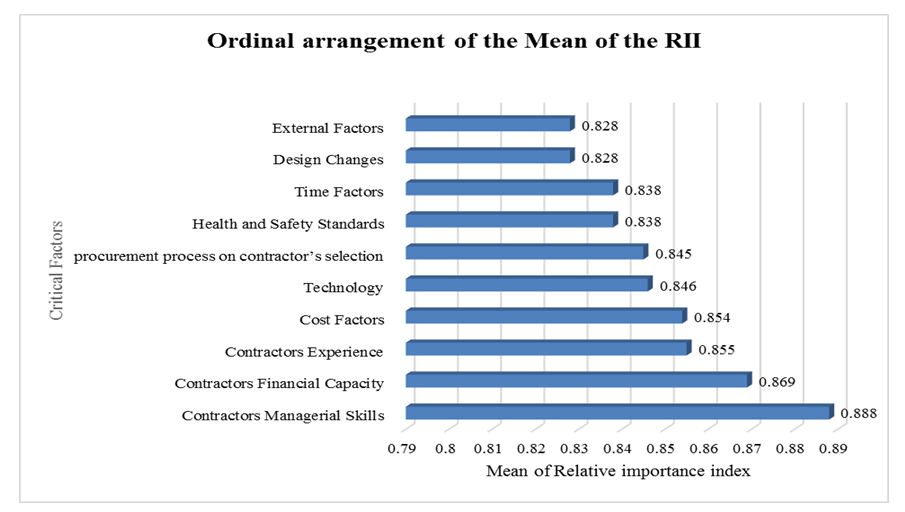 | Figure 1. Ordinal Arrangement of the Mean of the RII |
 | Figure 2. Contractors’ Experience (Source: Primary data, (2020)) |
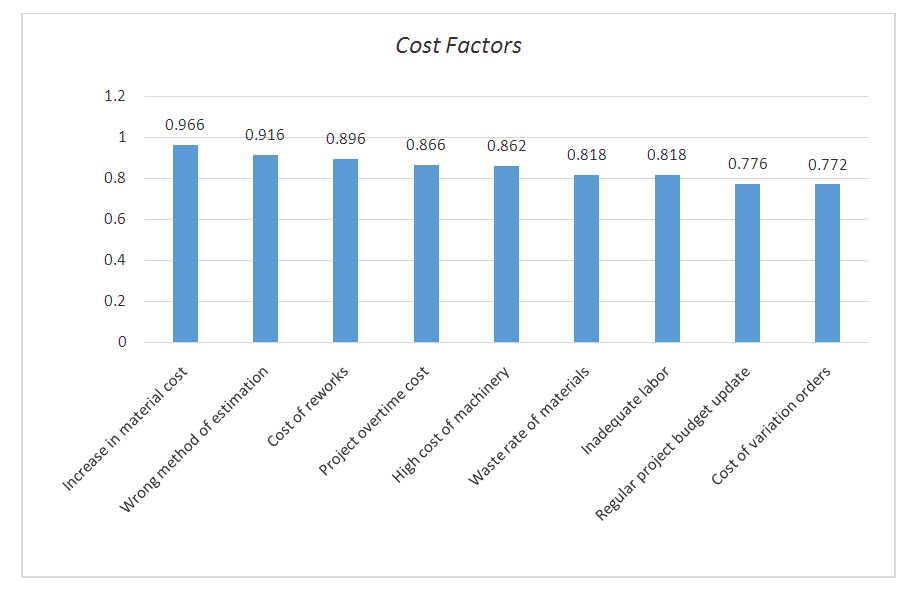 | Figure 3. Cost Factors (Source: Primary Data, (2020)) |
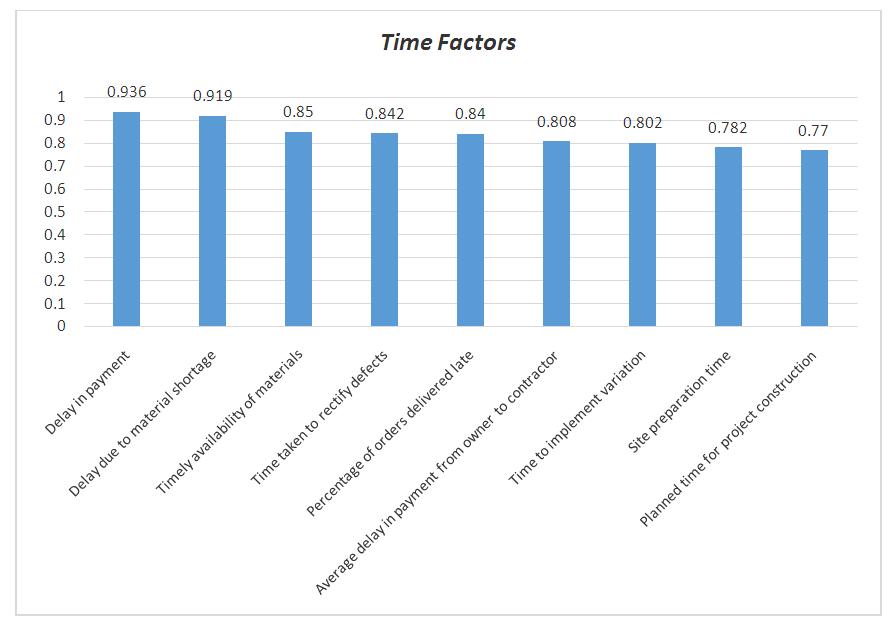 | Figure 4. Time Factors (Source: Primary Data, (2020)) |
4.1.1. Descriptive Statistics of Identified Critical Factors Affecting the Performance of Local Contractors
- Figure 5 shows how the identified critical factors behaved after analysing the collected data and the table was arranged starting with most impactful factor to the least impactful factor using the mean of RII. Example Contract Managerial skills had the highest mean of RII, lowest standard deviation and highest F-statistics with the lowest p-value implying that it was the most impactful critical factor on performance of road maintenance Local Contractors in Uganda.
|
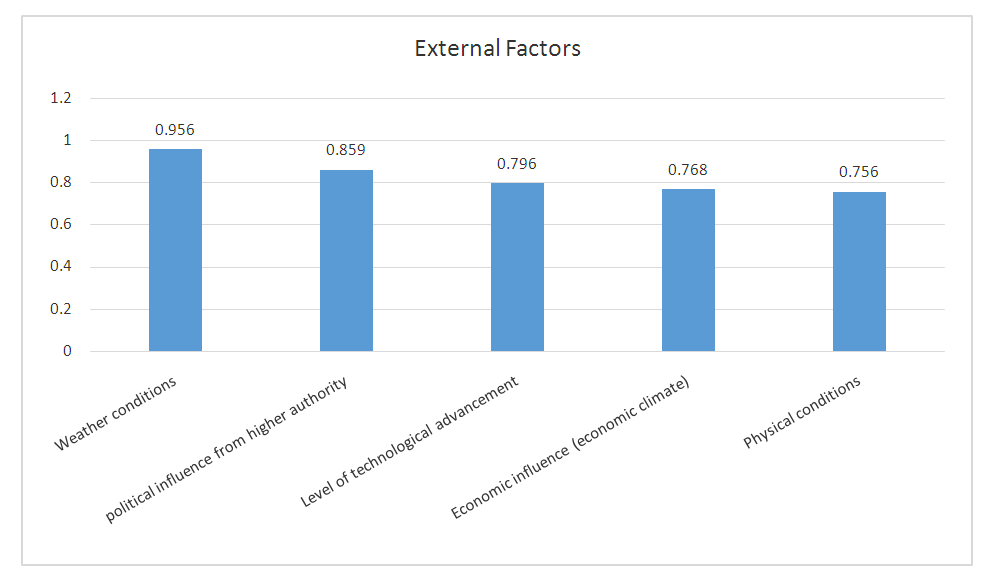 | Figure 5. External Factors (Source: Primary Data, (2020)) |
4.1.2. Impact of the Identified Critical Factors on Performance of Road Maintenance Local Contractors
- As before presented in Figure 5, the Contractors managerial skills was the most impactful factor affecting performance of road maintenance local contractors with RII of 0.888 followed by contractor’s financial capacity with RII of 0.869. External factors were the least impactful factors on the performance of road maintenance local contractors with IRR of 0.827 meaning that some of respondents regarded Contractor’s managerial skills as then most critical factor. However, the same variable had the lowest value of the standard deviation which was 0.236 close to 0 reflecting a small amount of variation in the group that was being studied and implying that respondents had similar opinions with regards to the statements about Contractor’s managerial skills. The ratio of the estimates of variability was 451.121 under the column indicated (F (1,8)) =451.121 or F-Statistic. The probability of obtaining the F-ratio of 451.121 was 0.000 (P value) which was very small as compared to the level of significance of 0.05, implying that the variable Contractor’s Managerial skills has significant impact on the performance of road maintenance local contractors.
4.1.3. Framework for Improvement of Performance of Road Maintenance Local Contractors
- As presented in Figure 6, the study established that performance of the local contractors was a function of the implementation phase and the planning phase of the local construction projects. The framework suggested that the planning phase of the local construction project is usually affected by the contractor’s managerial skills and the contractor’s level of experience, thus an improvement in the contractor’s managerial skill and having highly experienced contractors will improve the planning phase. This study also suggested that implementation of projects in Uganda’s construction industry by local contractors depends on the level of contractor’s financial capacity, the cost factors, technology, procurement process, health and safety standards, time factors and design changes. Thus, an improvement in the level of contractor’s financial capacity, cost factors, technology, procurement process, health and safety standards, time factors and proper management of design changes will improve the performance of local contractors. This study also considered external factors such as political interference, legal issues among others affect the implementation phase. Implying that minimizing the influence of external factors will also improve the performance of local contractors. This study therefore proposes the framework in Figure 6 to be used by the ministry of works and transport sector of Uganda for the improvement of performance of road maintenance local contractors in Uganda.
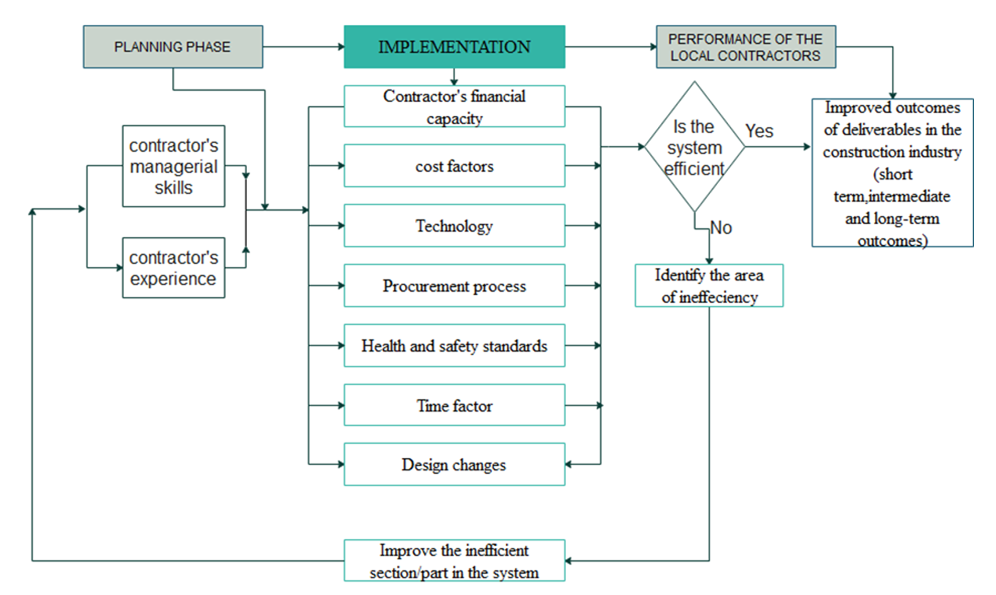 | Figure 6. A framework for improvement of performance of the local contractors |
5. Conclusions
- This study showed that contractors experience, Contractors Managerial skills, Contractor’s financial capacity, Procurement process on contractor’s selection, Cost Factors, Time factor, Design change, Technology, External Factors and Health and safety standard are the critical factors affecting the performance of road maintenance local contractor’s in Uganda with contractors Managerial skills having the greatest impact on performance of road maintenance Local Contractor’s since it had the highest mean of RII, lowest standard deviation and highest F-statistics with the lowest p-value hence the most impactful factor on performance of road maintenance Local Contractor’s in Uganda. The variables Contractors Financial Capacity, Contractors Experience, Cost Factors, Technology, procurement process on contractor’s selection, Health and Safety Standards, Time Factors and Design Changes are arranged according to their level of impact on Local Contractor’s performance in road maintenance projects in Uganda with the most impactful being Contractors Financial Capacity which comes immediately after Contracts Managerial skills and the least impactful being Design Changes. This study also indicated that External Factors was the least impactful factor on Local Contractor’s performance in road maintenance projects since they had the smallest value of the average of RII, highest standard deviation and lowest F-statistics with the highest p-value greater than 0.05 implying that they are the least impactful factor that affect the performance of road maintenance Local Contractor’s in Uganda.The study also concluded that the framework developed for improvement of performance of road maintenance local contractors considered the planning phase of the local construction project to be affected by the Constructors Managerial Skills and the contractor’s level of experience. The study further concluded that implementation of projects in Uganda is greatly affected by Contractors Financial Capacity and Cost Factors.
6. Recommendations
- This section presents the suggestions of the best course of action for Uganda National Road Authority (UNRA) Lira Station and local contractors to adopt in a bid to improve the performance of road maintenance local contractors in Uganda. It’s presented objective by objective guided by the flow of variables in the conceptual framework. The recommendations made by the researcher are entirely as a result of the findings of this study. This study suggested that Uganda National Road Authority (UNRA) specifically Lira Station and local contractors should put more emphasis on the following factors if they are to reap improved performance from road maintenance local contractor’s in Uganda these factors include contractors experience, Contractor’s financial capacity, Procurement process on contractor’s selection, Cost Factors, Time factor, Design change, Technology, External Factors and Health and safety standard. The study recommended that Uganda National Road Authority (UNRA) specifically Lira Station, local contractors and other stakeholders should put into more focus on Contractors Managerial skills since it had the greatest impact on performance of road maintenance Local Contractor’s, followed by Contractors Financial Capacity, Contractors Experience, Cost Factors, Technology, procurement process on contractor’s selection, Health and Safety Standards, Time Factors, Design Changes and External Factors respectively with little emphasis on external factors as compared to the preceding factors.The study also recommended that Uganda National Road Authority (UNRA) specifically Lira Station, local contractors and other stakeholders ought to regard road maintenance local construction projects in two main phases that include planning phase and implementation phase of the projects.It was further suggested that to ensure effectiveness at the planning phase of the local construction projects, stakeholders should focus more on Constructors Managerial Skills and the contractor’s level of experience. In addition the study recommended that to enhance the implementation of projects, stakeholders should put more emphasis on the Contractors Financial Capacity, the Cost Factors that may affect the project, the level of technology that the local contractor deploys, the local contractors level Procurement process on contractor’s selection, the existing level of Health and Safety Standards, the time factors in place, the design changes and as well as external factors which will subsequently facilitate the achievement of improved performance of road maintenance local contractors in Uganda.
7. Areas for Further Studies
- The researcher recommends that further research should be conducted in the area Contracting local contracts and its effects on the performance of road maintenance local contractors in Uganda considering a case of Uganda National Road Authority (UNRA) Lira Station.
 Abstract
Abstract Reference
Reference Full-Text PDF
Full-Text PDF Full-text HTML
Full-text HTML